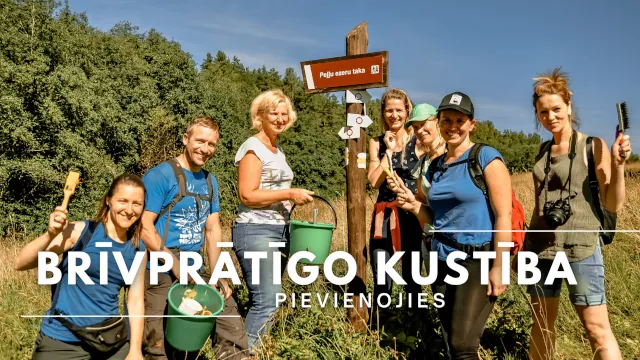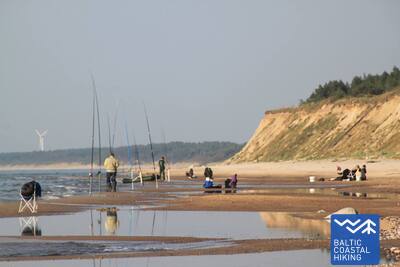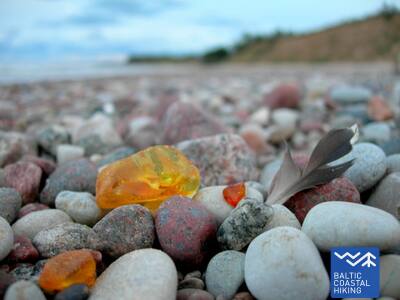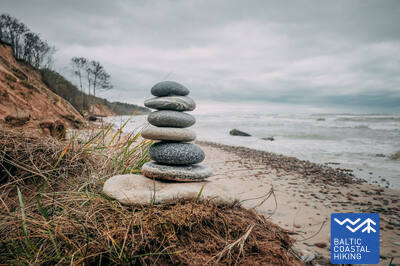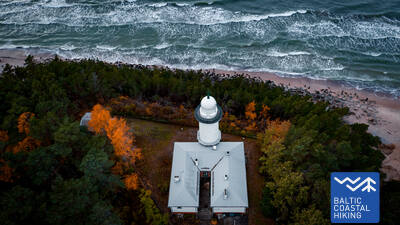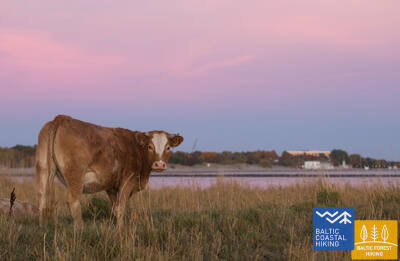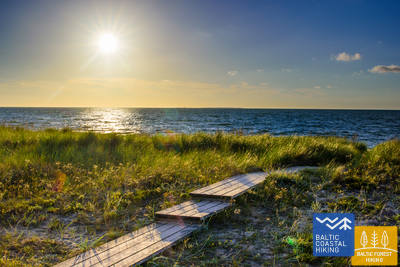Baltic Coastal Hiking trail - Dream tour
 Section 4. Karosta (The War Port) - Ziemupe.
Section 4. Karosta (The War Port) - Ziemupe.
Karosta - Military Heritage On The Coast Of The Baltic Sea
The first four kilometers of the Baltic Coastal Hiking Route may interest military history enthusiasts with the remains of many forts and coastal defense batteries, but in terms of walking, this is technically the most complicated section of Kurzeme seacoast. After crossing the Fortress Canal, the Baltic Coastal Hiking Route winds through a coastal meadow for a short while, then darts onto a beach and continues as far as Ziemupe. The beach is wide, in times of stronger winds it gets narrower between the Lenkupe and Kārļupīte Rivers. In some places, there are small bluffs, the rest of the section is composed of high, occasionally washed away foredunes. It is said that a lot of ships have sunk in the depths of the Ziemupe River, one of them even had bronze cannons.
 Section 5. Ziemupe - Pāvilosta.
Section 5. Ziemupe - Pāvilosta.
The Singing Sand and Amber
This beach is rarely visited by people and you can gather pieces of amber and little stones with fossils and hear the singing sand beneath your feet. Near Ziemupe, beautiful bluffs appear, but further on near Akmensrags and Pāvilosta there are beautiful, occasionally washed off foredunes overgrown with sand ryegrass and marram grass. In some places, you can see grey dunes. The Akmeņrags Lighthouse will serve as a good place to rest. Pāvilosta, with its provincial charm and the scent of the harbor and smoked fish will bring you back from wilderness to civilization.
The section of Jurtaka between Ziemupi and Pāvilost is sparsely populated. During the occupation, it, like the rest of the Dijon coast, was a zone of the border regime, an area closed to visitors.
 Section 6. Pāvilosta - Jūrkalne.
Section 6. Pāvilosta - Jūrkalne.
The Most Outstanding Bluffs Around The Baltic Sea
To the northeast of Pāvilosta, there are excellent views of the grey dunes, while only a couple of kilometers further you can see the beginning of one of the most beautiful sections the Baltic Coastal Hiking Route with outstanding bluffs continuing for more than 20 km. The most interesting bluff scenery is located near Strante and Ulmale villages and the estuary of the Rīva River. In many places, orchids bloom on the lower part of coastal landslides in summer. In Jūrkalne and in its surroundings, you can see “two sunsets”: the first one from the beach and the second one from the top of the bluff a couple of moments later.
One of the most peculiar sections of the Latvian coast with excellent steep banks at Strantes, Ulmala, Jūrkalne, etc.
 Section 7. Jūrkalne - Sārnate.
Section 7. Jūrkalne - Sārnate.
The Place Where People Crossed The Baltic Sea In Boats
The astounding bluffs of the Baltic Sea continue in this section of the Baltic Coastal Hiking Route. Near Ošvalki village, it descends turning into a steeper foredune covered in thick osier wreaths, while opposite to Sārnate village distinct bluffs reappear. Here in this comparatively short walking section you can see several impressive sceneries.
An excellent scenic section, where the steep coast of the Baltic Sea continues, where active sea erosion processes take place.
 Section 8. Sārnate - Užava.
Section 8. Sārnate - Užava.
The Most Beautiful Scenery Of The Latvian Seacoast
Near Sārnate, you can still see the bluffs of the Baltic Sea, which slowly become lower towards the North and is replaced by a washed away dam of foredunes. Between Vendzavas village and the Užava Lighthouse, you can see coastal sceneries that are quite unusual for Latvia and that remind one of sandy and rocky deserts with sparse vegetation: it used to be a firing ground for the Soviet army. In this place and in the territories of former firing grounds located beyond the Užava Lighthouse, there are now grey foredunes. Getting closer to the estuary of the Užava River, the beach becomes wider and the dunes – lower. The most beautiful scenery of the Baltic Coastal Hiking Route can be seen from the top of the romantic Užava Lighthouse.
 Section 9. Užava - Ventspils.
Section 9. Užava - Ventspils.
Gather Your Amber Collection!
In this section of the Baltic Coastal Hiking Route, the first 6 km are a lonely stretch of the coast with a wide beach and low foredunes, the tops of which are covered in silvery sand ryegrass and marram grass tillers. After passing the Medole brook, an impressive bluff (~ 19 m high) rises before your eyes with a narrow rocky beach beneath it. The bluff quickly shrinks and then rises again two kilometers further. Between the bluffs, there is a former firing ground for the Soviet army. The last five kilometers of the Baltic Coastal Hiking Route to the South Pier in Ventspils lead through a wide sandy beach, the coastal side of which is delimited by the biotopes of grey dunes.
 Section 14. Sīkrags - Saunags.
Section 14. Sīkrags - Saunags.
The Livonian Coast
A wide sandy beach stretches from Sīkrags village up to Mazirbe beach which is crossed by the Mazirbe Stream. The Baltic Coastal Hiking Route leads out to the center of Mazirbe village where you can see the Livonian National House. Continuing through small forest and country roads past the former Mazirbe Naval school, it winds through small coastal Livonian villages: Košrags, Pitrags and then Saunags. The Livonian Coastline is the only place where you can learn about the cultural heritage of the other indigenous nation of Latvia. In this section, the indicating signs are in both the Latvian and Livonian language.
 Section 15. Saunags village – Kolka.
Section 15. Saunags village – Kolka.
The Heart Of Europe: Cape Kolka
The Baltic Coastal Hiking Route winds through small country and forest roads from Saunags village to Vaide village where it returns to the seacoast again. Wide sandy beaches stretch up to Cape Kolka turning into low sparse foredunes; wooded seaside dunes continue behind them. For around 2 km, there are washed away dunes followed by the Dumbrkalni Hills. Cape Kolka, the point where the Great Sea meets the Little Sea, is one of the most popular bird-watching sites on the Baltic seacoast.
 Section 16. Kolka - Ģipka.
Section 16. Kolka - Ģipka.
Along The “Closed Coast”
At Cape Kolka, when turning towards the Gulf, you can clearly see the difference between the “Great Sea” and the “Little Sea”. The first 10 km of the Baltic Coastal Hiking Route lead through the coastal area of the Slītere National Park: first, past pine trees that are washed into the sea, past the building of a former fishing kolkhoz, a ship berth and Ēvaži Bluff which is surrounded by an unusually narrow sandy beach with overhanging black alders. The next section of the trail leading to Ģipka also has a narrow sandy beach with pools created by the rich springfens and the mouths of small streams that are shallow in summer. During Soviet times, the seacoast of the Slītere National Park was a closed territory for two reasons: it was a frontier zone and a nature reserve.
 Section 19. Mērsrags - Engure.
Section 19. Mērsrags - Engure.
In the Engure Nature Park
A forest trail surrounded by pine trees leads you from the center of the village to the beach. Next, the Baltic Coastal Hiking Route meanders between a rocky seacoast richly overgrown with reeds and other grasses on one side and wooded seaside dunes on the other side. In some places, the beach is paved with small round stones, in other places you can see grey dunes with a rich variety of plants. Near Bērzciems village, there are large coastal meadows with shoals appearing far away in the sea that are suited for birdwatching. Overgrown seacoast continues up to Abragciems village, while from Abragciems to Engure there is a beach.
 Section 28. Lauči - Tūja.
Section 28. Lauči - Tūja.
The Bygone Times Of Sailing Ships
This section of the seacoast of Vidzeme is of outstanding scenic beauty with a lot of rocky capes and boulders in the sea alternating with small, sandy coves where the small streams and rivulets, which dry out in summer, flow into. Occasionally, the beach is completely covered with the gray backs of stones. In some places, small patches of reeds appear, while near Tūja you will see the first sandstone outcrops.
 Section 29. Tūja - Svētciems.
Section 29. Tūja - Svētciems.
The Rocky Beach of Vidzeme
One of the most beautiful sections of the Baltic Coastal Hiking Route, which begins by crossing the Zaķupīte River. Up to the Ķurmrags Lighthouse, there are mostly sandy beaches with small sections of stones. Further on, the Rocky Seashore of Vidzeme starts: capes alternate with small coves, while 4 m high sandstone outcrops emerge on the coast. Sandy beaches continue to prevail after passing Cape Meleki, while before the mouth of the Svētupe River the beach is thickly overgrown and reedy, so it must be bypassed via a forest trail.
 Section 34. Uulu - Pärnu.
Section 34. Uulu - Pärnu.
Along the Wetlands to Pärnu
First, the Baltic Coastal Hiking Route takes the old coastal roads surrounded by pine forests, but after passing Lottemaa Park it turns towards the sea and comes out at Reiu beach. Next, the hike continues across an overgrown beach (wide shoals when the winds create an outflow of water) and after a little less than 4 km you have to turn inland, cross a golf course and turn in the direction of Pärnu. Near the Raeküla district, it snakes along a small trail forming the border between the large coastal wetland and the forest. Having looped around the wetland for ~ 6 km, the Baltic Coastal Hiking Route emerges at Pärnu beach. Further on, the road goes through the western part of Pärnu Old Town, crosses the Pärnu River and the Sauga River and ends in the Vana-Pärnu district.
 Section 46. Haeska - Puise.
Section 46. Haeska - Puise.
Observing Birds and Nature in Matsalu National Park
One of the most beautiful sections of the Baltic Coastal Hiking Route in Matsalu National Park, which leads through the agricultural lands and coastal meadows located near Matsalu Bay, where thousands of migrating cranes and geese gather in autumn. There are excellent birdwatching sites with towers near Haeska village (coastal meadows, shallow coves, small islets, cattle pastures) and at Cape Puise (coastal meadows with pastures, shoals). The most panoramic views of the sea and strings of islands can be seen in the surroundings of Põgari-Sassi and Puise nina.
 Section 48. Rohuküla - Haapsalu - Uuemõisa.
Section 48. Rohuküla - Haapsalu - Uuemõisa.
The Most Popular Resort in Estonia - Haapsalu
A multifarious section of the Baltic Coastal Hiking Route. The first three kilometres of the itinerary go along the former Haapsalu – Rohuküla broad-gauge railway line, takes you on a stroll along Haapsalu Bay through Pullapää cape, crosses coastal forests, which contain health trails, and continues via coastal promenades and small streets around Haapsalu Town. After crossing a small wetland beyond the town, this section of the trail ends in the beautiful Uuemõisa Park.
A very diverse and colorful section of the Jūrtaka trail, where you can enjoy coastal nature, walk along the beautiful Haapsalu coastal promenades, explore the city's historic center, medieval castle, and stay in one of the historic wooden buildings. There is also the opportunity to learn about military and industrial heritage - Haapsalu railway station, Ugru castle, etc.
 Section 51. Riguldi - Dirhami.
Section 51. Riguldi - Dirhami.
A Place Marked by Meteorites
With the exception of the first 3 km, the itinerary goes along the seashore. It is mainly a sandy beach with beautiful foredunes, grey dunes and sea boulders. The beach may be covered in algae that has been washed ashore and it is occasionally overgrown with dense vegetation. Opposite Rooslepa village and in other places in the sea and on the coast, there are badly weathered stones or the so-called breccias that have melted and weathered as a result of an ancient meteorite explosion. At the destination of the itinerary, you can spend some time in a pub and from its terrace you will have a beautiful view of the sea and the port.
 Section 52. Dirhami - Nõva.
Section 52. Dirhami - Nõva.
The Harsh Northern Nature
An exceptionally multifaceted section of the Baltic Coastal Hiking Route in terms of landscapes, where you can already get an insight of the nature characteristic to the north coast of Estonia. The itinerary leads you along the seacoast for almost its entire length, where you will find beautiful sandy beaches near coves, beaches covered in boulders at capes, while dolomite layers uncover themselves in the northern part of Cape Põõsaspea (an excellent birdwatching site). The Baltic Coastal Hiking Route goes through Nõva Nature reserve where you will have exceptional views of the white and grey dunes. The beaches are popular for fishing and kite-boarding.
 Section 53. Nõva - Vihterpalu.
Section 53. Nõva - Vihterpalu.
Along the Gulf of Finland
Starting from Rannaküla and after bypassing the wetland, the Baltic Coastal Hiking Route crosses the small Nõva River and leads you to the beach at Keibu Bay (overgrown at the beginning) where a sandy seashore with dunes stretches before your eyes. Near Keibu Brook, it turns inland where its continuation coincides with the trail marked by the Estonian State Forest Management Centre: Peraküla – Aegviidu – Ähijärve. The trail snakes through the small Keibu village and emerges at the beach opposite Alliklepa village with beautiful juniper fields. Further on, the trail leads you between the sea and two small lakes that used to be coves. Opposite them, you will see dolomite outcrops in the seabed. Next, the trail takes a small road along the seacoast (you can see the Pakri Islands) until reaching Vintse village and then it turns towards Vihterpalu.
 Section 56. Paldiski - Kersalu.
Section 56. Paldiski - Kersalu.
Cliffs, a Lighthouse and Military Heritage
The Baltic Coastal Hiking Route leads around the Pakri Peninsula, from whose rocky shores you will discover the most beautiful coastal landscapes in northwest Estonia. It goes through the centre of Paldiski and, after having reached the fortress bastions of Peter I, it turns towards the Pakri Lighthouse going across the upper part of the impressive Pakri Cliffs. Further on up to Kersalu, there are both ups in the shape of rocks and downs where the Baltic Coastal Hiking Route meanders along a sandy and rocky seacoast and a beautiful pine forest. Pakri Cliffs are alluring both in cold winters, when impressive icefalls are formed here, and during the time of colourful leaves in autumn.
 Section 58. Laulasmaa - Vääna-Jõesuu.
Section 58. Laulasmaa - Vääna-Jõesuu.
The Most Beautiful Waterfall in Estonia
A multifaceted section of the Baltic Coastal Hiking Route in terms of landscape that is suitable for hardy hikers. There are both rocky and sandy beaches and good swimming areas, fascinating coastal pine forests, the astounding Türisalu Cliff wall and giant sea boulders. By taking the trails of the vast Keila forest park, you can go to the Keila waterfall, near which some fragments of the popular Latvian feature film Vella kalpi (Devil’s servants) were shot, and you can also get to know the exhibition dedicated to the life of coastal fishermen in Lohusalu village.
 Section 59. Vääna - Jõesuu - Tabasalu.
Section 59. Vääna - Jõesuu - Tabasalu.
The Fabled Suurupi Peninsula
One of the most complicated sections of the Baltic Coastal Hiking Route, suitable only for experienced hikers. The itinerary circles the Suurupi Peninsula where the dense forests conceal the military heritage of different eras. The Baltic Coastal Hiking Route meanders through overgrown and rocky seacoasts, birch groves, along former pioneer camps and sand-stone cliffs protecting coves with sharp capes. In some places, the sea uncovers its dolomite base, while in other places you can see boulder “islands”. At the end of the itinerary, one of the most astounding outcrops of the Estonian littoral rises before your eyes – the Rannamõisa Cliffs, which gives views of Kakumäe Bay and Peninsula and the towers of Tallinn’s Old Town.
 Section 64. Nida – Pervalka.
Section 64. Nida – Pervalka.
Along the coast of the Curonian Lagoon
The Baltic Coastal Hiking Route starts in the center of Nida, by the port. In Nida, the trail winds along the Curonian Lagoon walkway which offers beautiful views of the expansive waters all the way to Rusnė Island on the east coast of the Curonian Lagoon. Nida features the typical architecture of the Curonian Spit region — one-storey wooden buildings with tile or reed roofs and window shutters painted blue and white. From Nida to Bulvikis Cape (shortly before the cape there is an abandoned runway), the Baltic Coastal Hiking Route winds through single-track forest trails up and down the pine-covered dunes, occasionally coming out onto beachside meadows with scarce vegetation. Rest spots and bird watching towers are available along the trail. The next section features unique open seaside meadows covered in lichens and vegetation characteristic to the Curonian Spit. The Baltic Coastal Hiking Route follows the coastal walkway in the village of Preila. It then winds through forest trails, briefly also following a pedestrian/cyclist lane and coastal paths, eventually reaching Pervalka. This section leads through the Curonian Spit National Park.
The Curonian Spit is one of the most impressive coastal formations in the Baltic States, featuring moving sand dunes, forested dunes, dune ridges, sandy habitats, and unique landscapes. The Coastal Trail (Jūrtaka) winds along the seashore or through small trails among the dunes. The landscape of the Curonian Spit is beautifully complemented by the former Kursenieki fishing villages, with their distinctive architecture and traditions. It is part of the Curonian Spit National Park.
 Section 65. Pervalka – Juodkrantė.
Section 65. Pervalka – Juodkrantė.
Along the most majestic sand dunes in Northern Europe
Having departed Pervalka, the Baltic Coastal Hiking Route follows a pedestrian path to cross the Curonian Spit in an east–western direction, arriving at the coast of the Baltic Sea. The next section of 13 km leads along a beautiful, sandy beach protected by high and steep sand dunes on the east. It is called the protective dune ridge and it has been man-made in order to protect the inland from the movement of sand. Entering Juodkrantė, the Baltic Coastal Hiking Route turns eastward and crosses the Curonian Spit once again over wooded and steep dunes, to reach the Curonian Lagoon coast. The Baltic Coastal Hiking Route briefly coincides with the Hill of Witches trail. It then follows the Juodkrantė beachside walkway to the port. This section leads through the Curonian Spit National Park.
The Curonian Spit is one of the most impressive coastal formations in the Baltic States, featuring moving dunes, forested dunes, dune ridges, sandy habitats, and unique landscapes. The Coastal Trail (Jūrtaka) follows the seashore or small trails through the dunes. The landscape of the Curonian Spit is beautifully complemented by the former Kursenieki fishing villages, with their distinctive architecture and traditions. It is part of the Curonian Spit National Park.
 Section 66. Juodkrantė – Klaipėda.
Section 66. Juodkrantė – Klaipėda.
Klaipėda — Lithuania’s gate to the sea
Having left the Juodkrantė beachside walkway, the Baltic Coastal Hiking Route crosses the Curonian Spit in a southeast–northwest direction leading along single-track forest trails that wind through the steep, pine-covered dunes until it eventually comes back out onto the coast of the Baltic Sea. For the next 9 km, the Baltic Coastal Hiking Route follows the coastline along sandy beaches. The steep foredune on the eastern side protects the inland from the moving sand. After Alksnynė village (not seen from the beach), the Baltic Coastal Hiking Route turns eastward, crossing a hillock covered in Pinus mugo pines and a World War II German army base, eventually approaching the coast of the Curonian Lagoon. Then the trail winds across the ridges of pine-covered dunes, providing regular views of Klaipėda Port. The route between the New and Old Ferry Port first follows a single-track path, and later a beachside walkway. Having crossed the Curonian Lagoon from the Old Ferry Port, the Baltic Coastal Hiking Route arrives in the center of Klaipėda where it follows Danės Street to the Birža Bridge. The section until Smiltynė leads through the Curonian Spit National Park.
The Curonian Spit is one of the most impressive coastal formations in the Baltic States, featuring moving dunes, forested dunes, dune ridges, sandy habitats, and unique landscapes. The Coastal Trail (Jūrtaka) winds along the seashore or through small trails among the dunes. The landscape of the Curonian Spit is beautifully complemented by the former Kursenieki fishing villages, with their distinctive architecture and traditions. It is part of the Curonian Spit National Park.
 Section 69. Rusnė Island.
Section 69. Rusnė Island.
Rusnė Island — excellent location for wildlife observation
The Baltic Coastal Hiking Route starts in the village of Rusnė on Rusnė Island. The trail leads through Neringos Street and K. Jukštaičio Street out into Rusnė Village beachside walkway extending along the Pakalnė River — one of the biggest distributaries of the Nemunas Delta. The Baltic Coastal Hiking Route further leads through the small port of Rusnė snaking through the polder dikes of Rusnė over to the village of Pakalnė, providing wonderful views along the way of the colourful architecture of the island and the willow trees overhanging the Pakalnė waters. After the Village of Pakalnė, up until Uostadvaris Lighthouse, the route mostly follows the Rusnė polder dikes, which enclose and interweave the low island (there is a spot on the island that is below sea level) to protect it from flooding. From the lighthouse to the village of Rusnė, the Baltic Coastal Hiking Route goes along the side of a paved road (except in the village of Uostadvaris, where the trail follows the polder dike on the bank of the Atmata River). In the village of Rusnė, the trail follows Kuršmarių Street and Taikos Street back to its starting point. Rusnė Island is located inside the Nemunas Delta Regional Park. The polder dikes are excellent for observing wildlife in the low flatlands — roe deer, elk and birds during spring and autumn migration can be seen here.











